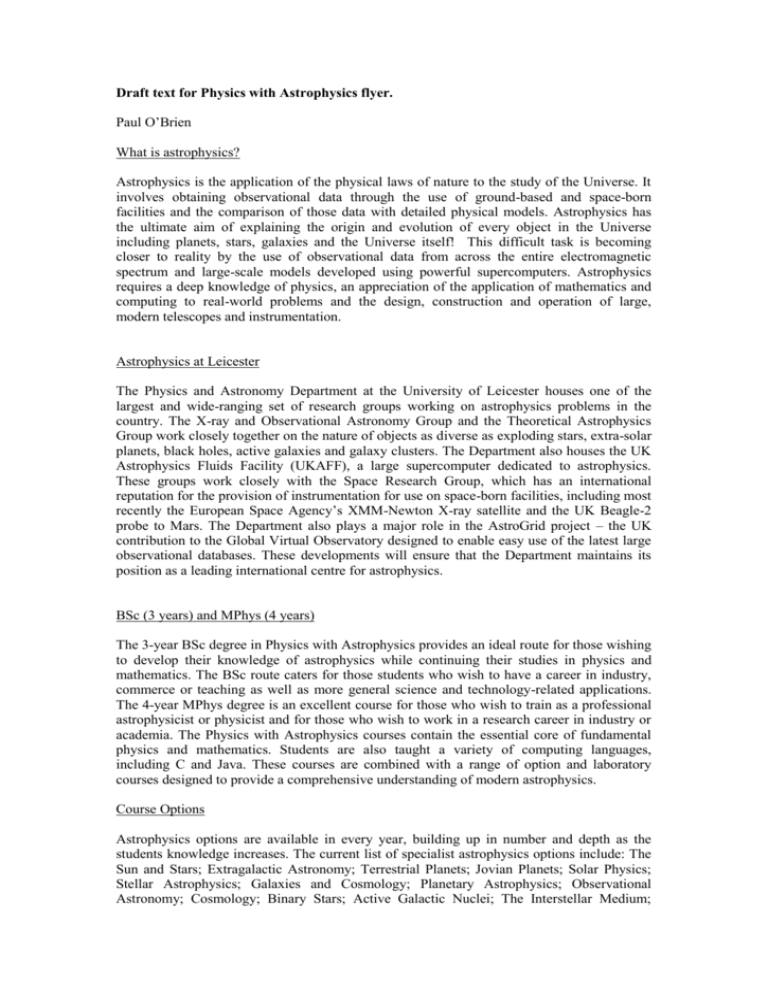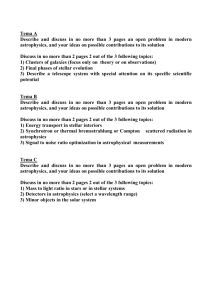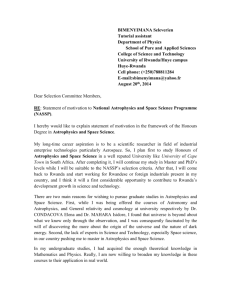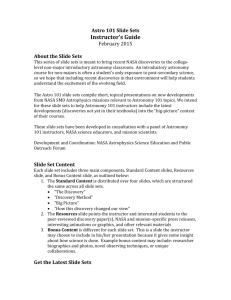astrophysics
advertisement

Draft text for Physics with Astrophysics flyer. Paul O’Brien What is astrophysics? Astrophysics is the application of the physical laws of nature to the study of the Universe. It involves obtaining observational data through the use of ground-based and space-born facilities and the comparison of those data with detailed physical models. Astrophysics has the ultimate aim of explaining the origin and evolution of every object in the Universe including planets, stars, galaxies and the Universe itself! This difficult task is becoming closer to reality by the use of observational data from across the entire electromagnetic spectrum and large-scale models developed using powerful supercomputers. Astrophysics requires a deep knowledge of physics, an appreciation of the application of mathematics and computing to real-world problems and the design, construction and operation of large, modern telescopes and instrumentation. Astrophysics at Leicester The Physics and Astronomy Department at the University of Leicester houses one of the largest and wide-ranging set of research groups working on astrophysics problems in the country. The X-ray and Observational Astronomy Group and the Theoretical Astrophysics Group work closely together on the nature of objects as diverse as exploding stars, extra-solar planets, black holes, active galaxies and galaxy clusters. The Department also houses the UK Astrophysics Fluids Facility (UKAFF), a large supercomputer dedicated to astrophysics. These groups work closely with the Space Research Group, which has an international reputation for the provision of instrumentation for use on space-born facilities, including most recently the European Space Agency’s XMM-Newton X-ray satellite and the UK Beagle-2 probe to Mars. The Department also plays a major role in the AstroGrid project – the UK contribution to the Global Virtual Observatory designed to enable easy use of the latest large observational databases. These developments will ensure that the Department maintains its position as a leading international centre for astrophysics. BSc (3 years) and MPhys (4 years) The 3-year BSc degree in Physics with Astrophysics provides an ideal route for those wishing to develop their knowledge of astrophysics while continuing their studies in physics and mathematics. The BSc route caters for those students who wish to have a career in industry, commerce or teaching as well as more general science and technology-related applications. The 4-year MPhys degree is an excellent course for those who wish to train as a professional astrophysicist or physicist and for those who wish to work in a research career in industry or academia. The Physics with Astrophysics courses contain the essential core of fundamental physics and mathematics. Students are also taught a variety of computing languages, including C and Java. These courses are combined with a range of option and laboratory courses designed to provide a comprehensive understanding of modern astrophysics. Course Options Astrophysics options are available in every year, building up in number and depth as the students knowledge increases. The current list of specialist astrophysics options include: The Sun and Stars; Extragalactic Astronomy; Terrestrial Planets; Jovian Planets; Solar Physics; Stellar Astrophysics; Galaxies and Cosmology; Planetary Astrophysics; Observational Astronomy; Cosmology; Binary Stars; Active Galactic Nuclei; The Interstellar Medium; Multi-waveband Astronomy; Relativistic Astrophysics and Cosmological Structures. Options are also available from our other degree courses. Students undertake large research projects in the third and fourth years. These can be theoretical in nature or use data taken with facilities such as the Hubble Space Telescope, XMM-Newton, or the Departments own observatory. Recent project titles include: Astrobiology; X-ray Telescope Mirrors; Binary Star Evolution; Physics of Comets; Black Holes in Galaxies; Extreme Quasars; Brown Dwarfs and Dense Stellar Environments.










